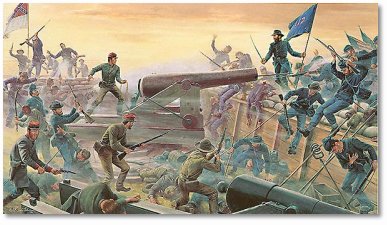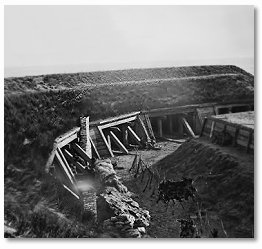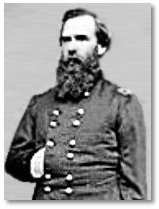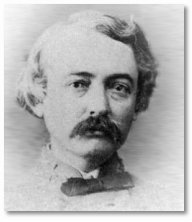|
|
|
MAIN MENU |
| Home |
| Civil War Battles |
|
TIMELINE |
| 1860 |
| 1861 |
| 1862 |
| 1863 |
| 1864 |
| 1865 |
|
VETERANS |
| Honor A Veteran |
| View Veterans |
| Women In The War |
|
MUSIC |
| Union |
| Confederate |
|
UNIFORMS |
| Union |
| Confederate |
|
WEAPONS |
| Union |
| Confederate |
|
CONTACT US |
| Guestbook |
CIVIL WAR BATTLES - Battle of Fort Fisher
|
January 13 - 15, 1865
|
 The Battle of Fort Fisher was a joint assault by the Union Army and Naval forces on Fort Fisher, located just outside Wilmington, N.C. Alfred Terry had sent out a division of colored troops, under the command of Charles J. Paine, to hold off Hoke's division on the peninsula. Terry's other division, supported by an independent brigade, moved down the peninsula and attacked the land face of the fort. Porter had organized a landing force of 2,000 sailors and marines to attack the sea face of the fort.
The Battle of Fort Fisher was a joint assault by the Union Army and Naval forces on Fort Fisher, located just outside Wilmington, N.C. Alfred Terry had sent out a division of colored troops, under the command of Charles J. Paine, to hold off Hoke's division on the peninsula. Terry's other division, supported by an independent brigade, moved down the peninsula and attacked the land face of the fort. Porter had organized a landing force of 2,000 sailors and marines to attack the sea face of the fort.
On Jan. 15th Porter's gunboats opened fire on the sea face of the fort and by noon all but two guns had been silenced. Hoke had sent 1,000 troops from his line to Fort Fisher during the bombardments. However, only about 400 were able to land and make it to the defense while the others were forced to turn back. At this time, the sailors and marines under the command of Lt. Commander Kirk R. Breese, landed and moved against the point where the fort's land and sea faces met, known as the "pulpit". The attack was a disaster. The marines were supposed to provide cover for the charging sailors, instead, the assault went forward in an unorganized mass. However, the attack did draw Confederate attention away from the river gate, where Gen. Ames prepared to launch his attack. He sent forth his first brigade at 2:00 pm., under the command of Brevet Brig. Gen. Newton Martin Curtis. An advance guard from Curtis's brigade used axes to cut through the palisades and abatis.
 Curtis's brigade took heavy casualties as they overran the outer works and stormed the first traverse. At this point Ames ordered Pennypacker's brigade forward, which he accompanied into the fort. As Ames marched forward, Confederate snipers zeroed in on his party, and cut down a number of aides surrounding him. Pennypacker's men fought their way through the river gate side, and Gen. Ames ordered a portion of his men to fortify a position within the interior of the fort. Meanwhile, Confederate cannons at Battery Buchanan, fired on the northern wall as it fell into Union hands. Ames could see that Curtis's lead units were stalled at the fourth traverse, and ordered Bell's brigade forward. But Bell had been killed by sharpshooters before ever reaching the fort. Seeing the Union attackers crowd into the breach and interior, Gen. Whiting personally lead the counterattack. Whiting received multiple demands to surrender as he charged into the Union soldiers, when he refused he was shot down and killed.
Curtis's brigade took heavy casualties as they overran the outer works and stormed the first traverse. At this point Ames ordered Pennypacker's brigade forward, which he accompanied into the fort. As Ames marched forward, Confederate snipers zeroed in on his party, and cut down a number of aides surrounding him. Pennypacker's men fought their way through the river gate side, and Gen. Ames ordered a portion of his men to fortify a position within the interior of the fort. Meanwhile, Confederate cannons at Battery Buchanan, fired on the northern wall as it fell into Union hands. Ames could see that Curtis's lead units were stalled at the fourth traverse, and ordered Bell's brigade forward. But Bell had been killed by sharpshooters before ever reaching the fort. Seeing the Union attackers crowd into the breach and interior, Gen. Whiting personally lead the counterattack. Whiting received multiple demands to surrender as he charged into the Union soldiers, when he refused he was shot down and killed.
 Porter's gunboats helped maintain the Federal momentum. His gunners' aimed proved to be deadly accurate and began clearing out the defenders as the Union troops approached the sea wall. Curtis's troops gained the heavily contested fourth traverse. Col. Lamb began gathering up every last soldier in the fort, including the sick and wounded from the hospital, for a last ditch counterattack. Just as he was about to oder a charge, he fell severely wounded and was taken to the fort's hospital to be laid next to Gen. Whiting. General Ames had suggested that the Union troops entrench in their current positions. When Curtis heard this idea he grabbed a spade and hurled it over Confederate trenches and shouted, "Dig johnnies, for I'm comin for you." Curtis fell wounded, only an hour into the battle, as he went back to confer with Ames. Col. Pennypacker also fell wounded before the battle was over.
Porter's gunboats helped maintain the Federal momentum. His gunners' aimed proved to be deadly accurate and began clearing out the defenders as the Union troops approached the sea wall. Curtis's troops gained the heavily contested fourth traverse. Col. Lamb began gathering up every last soldier in the fort, including the sick and wounded from the hospital, for a last ditch counterattack. Just as he was about to oder a charge, he fell severely wounded and was taken to the fort's hospital to be laid next to Gen. Whiting. General Ames had suggested that the Union troops entrench in their current positions. When Curtis heard this idea he grabbed a spade and hurled it over Confederate trenches and shouted, "Dig johnnies, for I'm comin for you." Curtis fell wounded, only an hour into the battle, as he went back to confer with Ames. Col. Pennypacker also fell wounded before the battle was over.
 The battle lasted for hours, long after dark, as shells plunged in from the sea and Gen. Ames struggled with a division that became increasingly more unorganized as his regimental leaders and all of his brigade leaders lay either dead or wounded. Gen. Terry sent Abbott's brigade forward to reinforce the attack, then joined Ames in the interior of the fortress. Still believing the situation in Fort Fisher was under control and tired of Whiting's demands, Bragg dispatched Gen. Alfred H. Colquitt to relieve Whiting and assume command at Fort Fisher. Colquitt landed at 9:30 pm at the southern base of the fort just as Lamb, Whiting and the Confederate wounded were being evacuated to Battery Buchanan. The Confederate hold on Fort Fisher was untenable, and after another attack by Terry and his men the defeat was unmistakable. Major Reilly held up a white flag and walked into the Union lines to announce the Fort would surrender. Just before 10:00 pm, Terry rode to Battery Buchanan to receive the official surrender of the Fort from General whiting.
The battle lasted for hours, long after dark, as shells plunged in from the sea and Gen. Ames struggled with a division that became increasingly more unorganized as his regimental leaders and all of his brigade leaders lay either dead or wounded. Gen. Terry sent Abbott's brigade forward to reinforce the attack, then joined Ames in the interior of the fortress. Still believing the situation in Fort Fisher was under control and tired of Whiting's demands, Bragg dispatched Gen. Alfred H. Colquitt to relieve Whiting and assume command at Fort Fisher. Colquitt landed at 9:30 pm at the southern base of the fort just as Lamb, Whiting and the Confederate wounded were being evacuated to Battery Buchanan. The Confederate hold on Fort Fisher was untenable, and after another attack by Terry and his men the defeat was unmistakable. Major Reilly held up a white flag and walked into the Union lines to announce the Fort would surrender. Just before 10:00 pm, Terry rode to Battery Buchanan to receive the official surrender of the Fort from General whiting.
|
